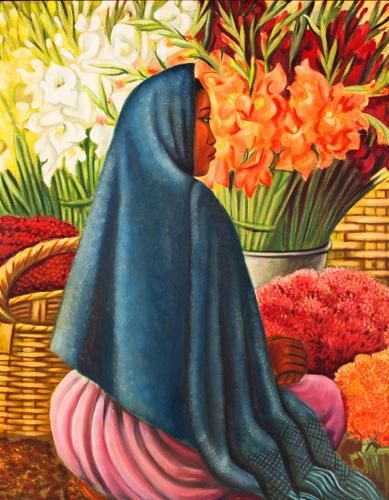In the catalog for Miguel Covarrubias: Drawing a Cosmopolitan Line, the new exhibit at the Georgia O’Keeffe Museum, a sketch by René d’Harnoncourt, director of New York’s Museum of Modern Art from 1949 to 1967, depicts Covarrubias hurling a large Olmec head onto a gaggle of archaeologists preoccupied with excavating Mayan artifacts. You won’t find d’Harnoncourt’s ink drawing in this show, but it does offer insight into the preoccupations of an artist primarily known in the United States for his caricatures of celebrities and political figures. It’s not enough to say that Covarrubias — whose humorous depictions of the Hollywood elite and other cultural figures enlivened the covers and pages of Vanity Fair, The New Yorker, Vogue, and other magazines — had interests and talents in areas other than illustration and painting (along with lithography and mural work). Over his lifetime (1904-1957), the native of Mexico City functioned at various points as art historian, archaeologist and ethnologist, curator, dancer, and costume and set designer for theatrical productions. The story behind d’Harnoncourt’s witty depiction of Covarrubias exists almost as metaphor for the man himself, how his artwork has achieved a posthumous popularity while his scholarly pursuits are better known in academic circles. He popularized the art and cultures of the Americas and of Bali (where he and his new wife, Rosa, a dancer choreographer, and sometime photographer, honeymooned in 1930), making forays as well into the ancient art of China and other regions of the world.
Covarrubias was interested in Mexico’s Olmec culture and believed, accurately it turns out, that the Olmecs preceded the Maya — an idea that was met with resistance from archaeologists for most of the first half of the 20th century.“For the first 40 years of the 20th century the evidence was slim for the Olmecs’ being earlier than the Maya, so it’s not surprising that the major figures in Maya studies opposed the thesis that Olmecs were earlier,” said Khristaan D. Villela, a professor of art history and scholar in residence at the Santa Fe University of Art and Design who writes Pasatiempo’s “Viajes Pintorescos y Arqueológicos” column. “You had a collection of free-floating orphan objects in museums and private collections. There was no archaeology. It was completely different from the Maya, where you have many decades of sustained archaeological research and lots of standing ruins.”
Despite this, Covarrubias and contemporaries like National Geographic Society archaeologist Matthew W. Stirling were correct about the Olmec: in the Mesoamerican timeline, Olmec culture is now known to have preceded Mayan. Few examples of the numerous detailed drawings Covarrubias made of Preclassic Mexican objects, some of whose excavations he supervised, are included in the exhibit. But there is one standout: an undated drawing titled Olmec Influence on the Evolution of the Jaguar Mask. Covarrubias’ stylistic concerns are what make his scholarship on Mexican antiquities relevant to an exhibit of an artist regarded as cosmopolitan and among the cultural elite. Like his caricatures, several of which are in the show, there’s a simplicity to his renderings, an economic use of line that cuts to the essence of what, for Covarrubias, was a piece of art’s aesthetic appeal.




